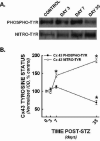Alterations in connexin 43 during diabetic cardiomyopathy: competition of tyrosine nitration versus phosphorylation
- PMID: 24796789
- PMCID: PMC4221578
- DOI: 10.1111/1753-0407.12164
Alterations in connexin 43 during diabetic cardiomyopathy: competition of tyrosine nitration versus phosphorylation
Abstract
Background: Cardiac conduction abnormalities are observed early in the progression of type 1 diabetes (T1D), but the mechanism(s) involved are undefined. Connexin 43, a critical component of ventricular gap junctions, depends on tyrosine phosphorylation status to modulate channel conductance; changes in connexin 43 content, distribution, and/or phosphorylation status may be involved in cardiac rhythm disturbances. We tested the hypothesis that cardiac content and/or distribution of connexin 43 is altered in a rat model of T1D cardiomyopathy, investigating a mechanistic role for tyrosine.
Methods: Electrocardiographic analyses were conducted during the progression of diabetic cardiomyopathy in rats dosed with streptozotocin (STZ; 65 mg/kg) 3, 7, and 35 days after the induction of diabetes. Following functional analyses, we conducted immunohistochemical and immunoprecipitation studies to assess alterations in connexin 43.
Results: There was significant evidence of ventricular conduction abnormalities (QRS complex, Q-T interval) as early as 7 days after STZ, persisting throughout the study. Connexin 43 levels were increased 7 days after STZ and remained elevated throughout the study. Connexin 40 content was unchanged relative to controls throughout the study. Changes in connexin 43 distribution were also observed: connexin 43 staining was dispersed from myocyte short axis junctions. Connexin 43 tyrosine phosphorylation declined during the progression of diabetes, with concurrent increases in tyrosine nitration.
Conclusions: The data suggest that changes in connexin 43 content and distribution occur during experimental diabetes and likely contribute to alterations in cardiac function, and that oxidative modification of tyrosine-mediated signaling may play a mechanistic role.
Keywords: cardiomyopathy; connexins; diabetes; oxidative stress; signal transduction; 关键词:心肌病,间隙连接蛋白,糖尿病,氧化应激,信号转导.
© 2014 Ruijin Hospital, Shanghai Jiaotong University School of Medicine and Wiley Publishing Asia Pty Ltd.
Figures






Similar articles
-
Curcumin prevents diabetic cardiomyopathy in streptozotocin-induced diabetic rats: possible involvement of PKC-MAPK signaling pathway.Eur J Pharm Sci. 2012 Oct 9;47(3):604-14. doi: 10.1016/j.ejps.2012.04.018. Epub 2012 Apr 28. Eur J Pharm Sci. 2012. PMID: 22564708
-
Gain of function of cardiac ryanodine receptor in a rat model of type 1 diabetes.Cardiovasc Res. 2011 Jul 15;91(2):300-9. doi: 10.1093/cvr/cvr076. Epub 2011 Mar 18. Cardiovasc Res. 2011. PMID: 21421556 Free PMC article.
-
Cardiac fibrosis and dysfunction in experimental diabetic cardiomyopathy are ameliorated by alpha-lipoic acid.Cardiovasc Diabetol. 2012 Jun 19;11:73. doi: 10.1186/1475-2840-11-73. Cardiovasc Diabetol. 2012. PMID: 22713251 Free PMC article.
-
Can We Prevent Mitochondrial Dysfunction and Diabetic Cardiomyopathy in Type 1 Diabetes Mellitus? Pathophysiology and Treatment Options.Int J Mol Sci. 2020 Apr 19;21(8):2852. doi: 10.3390/ijms21082852. Int J Mol Sci. 2020. PMID: 32325880 Free PMC article. Review.
-
Molecular mechanisms of diabetic cardiomyopathy.Diabetologia. 2014 Apr;57(4):660-71. doi: 10.1007/s00125-014-3171-6. Epub 2014 Jan 30. Diabetologia. 2014. PMID: 24477973 Free PMC article. Review.
Cited by
-
Targeting nitrative stress for attenuating cisplatin-induced downregulation of cochlear LIM domain only 4 and ototoxicity.Redox Biol. 2016 Dec;10:257-265. doi: 10.1016/j.redox.2016.10.016. Epub 2016 Oct 31. Redox Biol. 2016. PMID: 27821327 Free PMC article.
-
NADPH Oxidases and Oxidative Stress in the Pathogenesis of Atrial Fibrillation.Antioxidants (Basel). 2023 Oct 6;12(10):1833. doi: 10.3390/antiox12101833. Antioxidants (Basel). 2023. PMID: 37891912 Free PMC article. Review.
-
Pinocembrin Decreases Atrial Fibrillation Susceptibility in a Rodent Model of Depression.Front Cardiovasc Med. 2022 May 20;9:766477. doi: 10.3389/fcvm.2022.766477. eCollection 2022. Front Cardiovasc Med. 2022. PMID: 35669473 Free PMC article.
-
Myocyte membrane and microdomain modifications in diabetes: determinants of ischemic tolerance and cardioprotection.Cardiovasc Diabetol. 2017 Dec 4;16(1):155. doi: 10.1186/s12933-017-0638-z. Cardiovasc Diabetol. 2017. PMID: 29202762 Free PMC article. Review.
-
Connexins in the Heart: Regulation, Function and Involvement in Cardiac Disease.Int J Mol Sci. 2021 Apr 23;22(9):4413. doi: 10.3390/ijms22094413. Int J Mol Sci. 2021. PMID: 33922534 Free PMC article. Review.
References
-
- Garcia MJ, McNamara PM, Gordon T, Kannel WB. Morbidity and mortality in diabetics in the Framingham population. Sixteen year follow-up study. Diabetes. 1974;23:105–11. - PubMed
-
- Gu K, Cowie CC, Harris MI. Diabetes and decline in heart disease mortality in US adults. Jama. 1999;281:1291–7. - PubMed
-
- Kannel WB, Hjortland M, Castelli WP. Role of diabetes in congestive heart failure: the Framingham study. Am J Cardiol. 1974;34:29–34. - PubMed
-
- Pieske B, Wachter R. Impact of diabetes and hypertension on the heart. Current opinion in cardiology. 2008;23:340–9. - PubMed
-
- Hayat SA, Patel B, Khattar RS, Malik RA. Diabetic cardiomyopathy: mechanisms, diagnosis and treatment. Clin Sci (Lond) 2004;107:539–57. - PubMed
Publication types
MeSH terms
Substances
Grants and funding
LinkOut - more resources
Full Text Sources
Other Literature Sources
Medical
Miscellaneous

